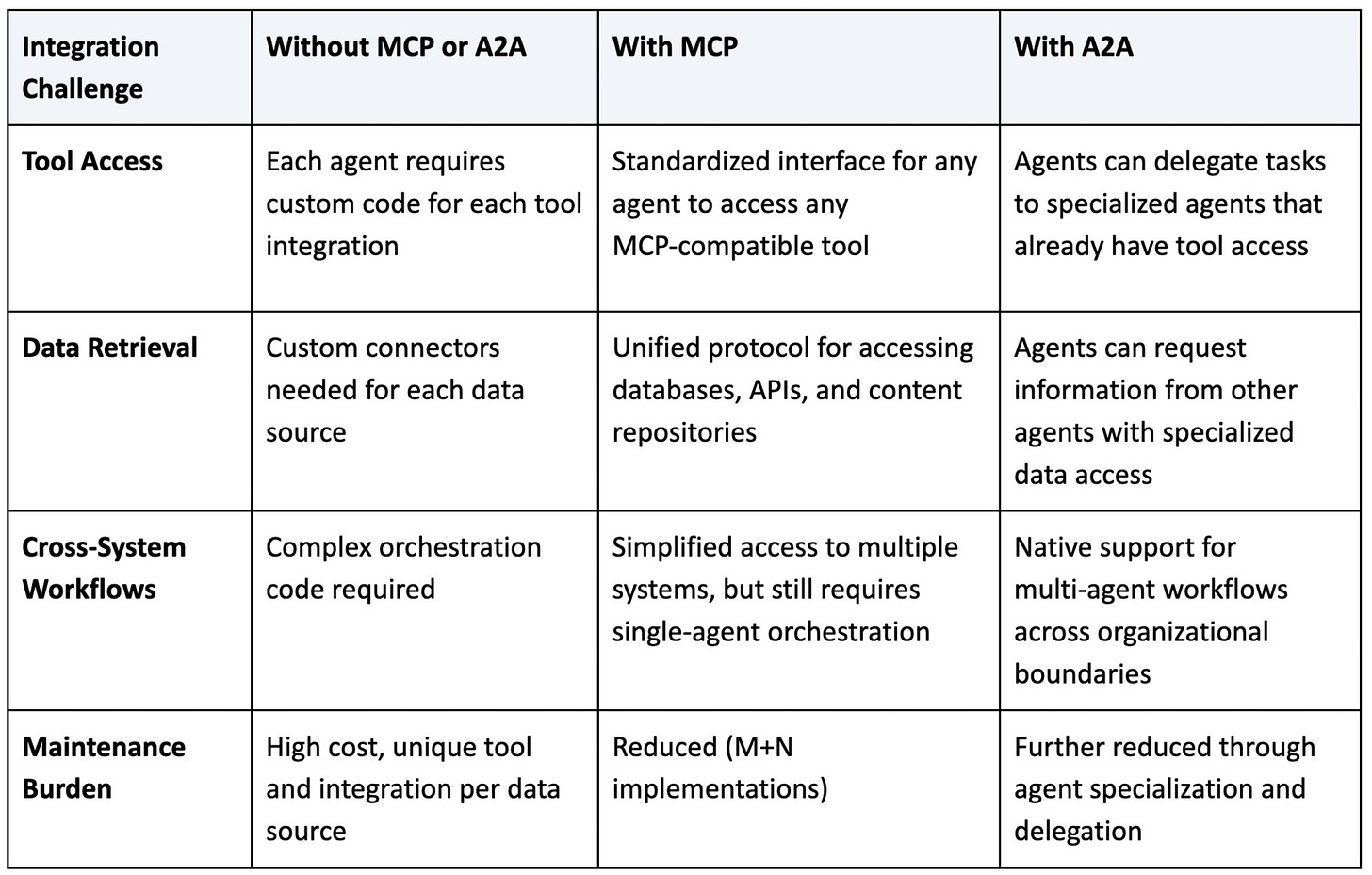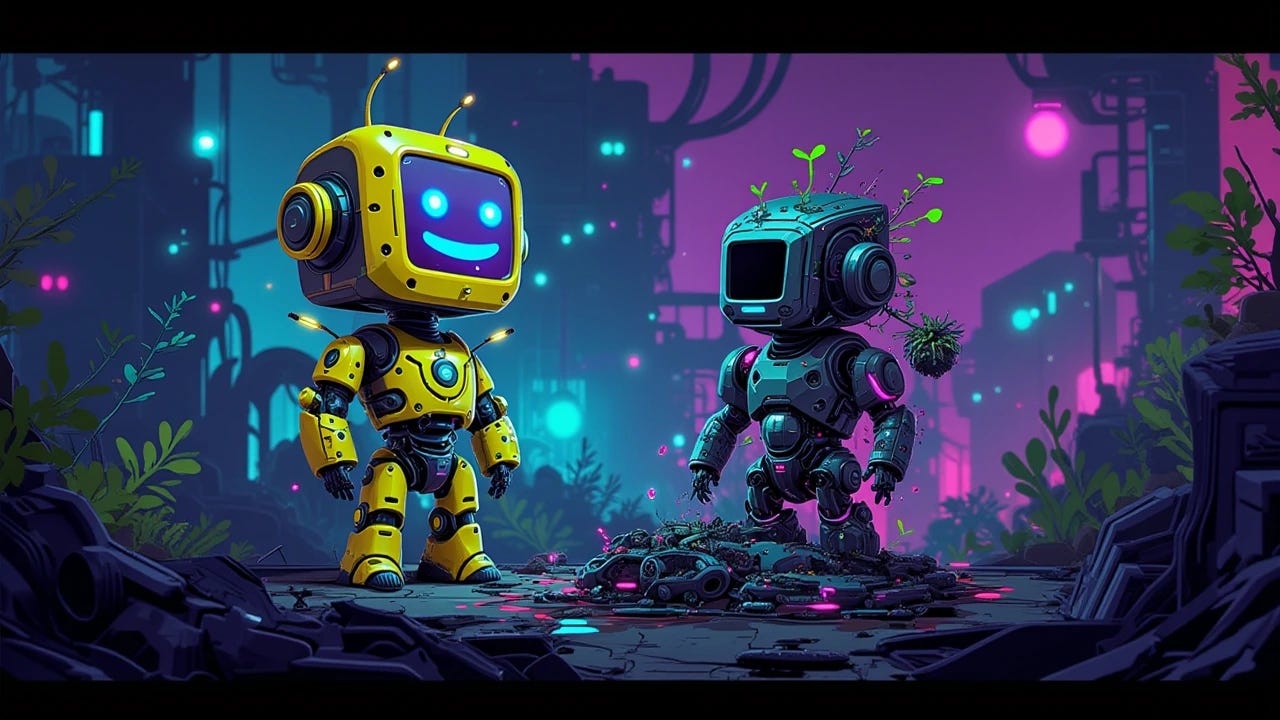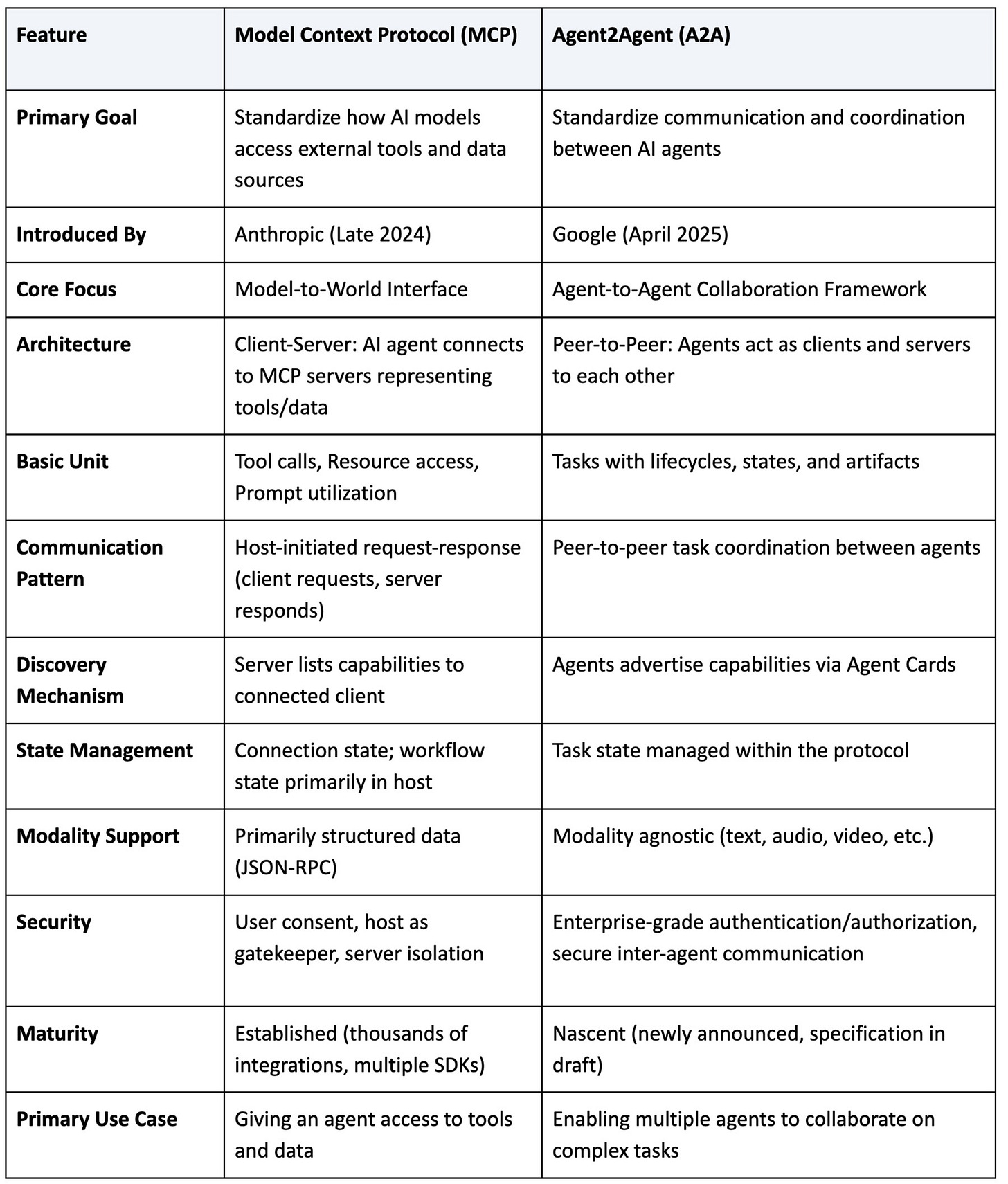Agents Today #15 - AI Agent Interoperability: Head-to-Head with MCP and A2A
Taking a look at how can AI agents could effectively work with tools, data sources, and other agents using Anthropic MCP and the newly announced Google A2A protocols
In today's rapidly evolving AI landscape, one of the largest challenges is: at scale, how can AI agents effectively work with tools, data sources, and other agents?
Two significant protocols have emerged to address different aspects of this challenge: Anthropic's Model Context Protocol (MCP) and Google's newly announced Agent2Agent (A2A) protocol. While MCP focuses on connecting AI models to external tools and data, A2A aims to enable seamless communication between agents themselves.
This article examines both protocols, their distinct purposes, capabilities, and how they could work together to create a more interoperable AI agent ecosystem.
Summary
The AI agent ecosystem is facing an interoperability challenge that limits its potential. Anthropic's MCP, introduced in late 2024, has gained significant traction as an open standard for connecting AI models to external tools and data sources, effectively solving the "having to build a new tool for every data problem" by standardizing these connections. Similar to how USB became a hardware protocol across mobile devices instead of a proprietary connector for each brand. Google's A2A protocol, announced in today with support from over 50 technology partners, addresses a different but complementary need: enabling AI agents to communicate with each other, regardless of their underlying frameworks or vendors. This article explores how MCP provides the foundation for individual agents to access tools and data (the "model-to-world interface"), while A2A creates the framework for agents to collaborate with each other (the "agent-to-agent collaboration framework"). Understanding these protocols and their complementary nature is essential for developers and enterprises looking to build sophisticated, interoperable agent systems. These aren't actually competing standards, rather MCP and A2A represent different layers of an AI agent interoperability stack that together could unlock the potential of multi-agent systems.
Mike's Insights
Throughout my career I've observed that the most powerful applications rarely exist in isolation. True AI agent potential emerges when systems can seamlessly connect to data sources, tools, and other AI agents.
I am very excited about how quickly the industry is converging around standardization. Just months after Anthropic introduced MCP, we've seen remarkable adoption across the ecosystem, with thousands of integrations developed and even competitors like OpenAI embracing the standard. The GitHub repository of Awesome MCP Servers now showcases implementations across virtually every domain—from databases and developer tools to finance and communication platforms.
However, as I've spoken with developers and enterprises trying to implement agent-based systems, it's become clear that MCP alone doesn't solve the entire interoperability puzzle. While MCP excellently addresses how an agent connects to tools and data, it doesn't define how agents communicate with each other. Google's introduction of A2A fills a critical gap, focusing on agent-to-agent communication beyond the agent-to-tool integration.
I believe we're witnessing the beginning of a layered interoperability stack for AI agents. MCP provides the foundation—connecting agents to the data and tools they need—while A2A builds on this by enabling agents to collaborate with each other. This isn't about competing standards but complementary ones that address different aspects of the same challenge.
For organizations exploring agent ecosystems, understanding both protocols will be essential. The most powerful implementations will likely leverage MCP for internal tool integration and A2A for agent orchestration across organizations, creating truly collaborative systems that can tackle complex workflows beyond organizational boundaries.
Understanding the Role of Tools in AI Agents
AI agents derive much of their power from their ability to interact with the world beyond their training data. Tools enable agents to access real-time information, perform actions, and extend their capabilities beyond what's encoded in their parameters. However, without standardization, connecting agents to tools has historically required custom integrations for each new tool or data source.
This integration challenge limits the practical utility of AI agents in enterprise settings, where access to diverse systems and data sources is essential. As Anthropic noted when introducing MCP, "even the most sophisticated models are constrained by their isolation from data—trapped behind information silos and legacy systems."
Model Context Protocol (MCP): Connecting Agents to Tools and Data
MCP was introduced as an open standard for connecting AI models to external data sources and tools. As Anthropic described it, MCP aims to "help frontier models produce better, more relevant responses" by providing a "universal, open standard for connecting AI systems with data sources, replacing fragmented integrations with a single protocol."
MCP follows a client-server architecture with three key components:
Host: The main AI application that users interact with (e.g., Claude or Gemini)
MCP Client: A connector that manages communication with a specific server
MCP Server: A service that exposes data sources or tools via the MCP interface
The protocol defines several types of capabilities that servers can provide:
Tools: Functions that the AI model can invoke to perform actions
Resources: Read-only data access controlled by the application
Prompts: Pre-defined templates or workflows for common tasks
Sampling: Allows servers to request model completions from the client
As an example, the Awesome MCP List GitHub repository showcases this growth, cataloging over 170 MCP servers across 18 categories including:
Browser Control (9 servers)
Cloud Platforms (8 servers)
Communication (12 servers)
Databases (42 servers)
Developer Tools (19 servers)
File Systems (8 servers)
Finance & Fintech (18 servers)
Knowledge & Memory (6 servers)
These implementations range from official servers provided by Anthropic (Google Drive, Slack, GitHub, PostgreSQL, etc.) to community-built connectors for virtually every major platform and service. Major technology companies including Microsoft, OpenAI, and Google have embraced MCP, with OpenAI announcing in March 2025 that it would add MCP support across its products.
Agent2Agent (A2A): Enabling Inter-Agent Communication
While MCP addresses how agents connect to tools and data, Google's A2A protocol focuses on a different challenge: how agents communicate with each other. Announced today with support from over 50 technology partners, A2A provides "a standard way for agents to collaborate with each other, regardless of the underlying framework or vendor."
A2A facilitates communication between what Google calls a client agent and a remote agent. The client agent formulates and communicates tasks, while the remote agent acts on those tasks to provide information or take actions. This interaction involves several key capabilities:
Capability Discovery: Agents advertise their capabilities using an "Agent Card" in JSON format, allowing client agents to identify the best agent for a specific task.
Task Management: Communication is oriented around task completion, with each task having a defined lifecycle and producing an artifact as output.
Collaboration: Agents can exchange messages containing memory/context, replies, artifacts, or user instructions.
User Experience Negotiation: Messages include parts with specified content types, allowing agents to negotiate the correct format.
Per Google's announcement, A2A is designed around five key principles:
Embrace agentic capabilities: Enabling true multi-agent collaboration without limiting agents to "tools"
Built on existing standards: Using HTTP, SSE, and JSON-RPC for easier integration
Secure by default: Supporting enterprise-grade authentication and authorization
Support for long-running tasks: Handling everything from quick tasks to deep research that may take hours or days
Multimodal: Including text, audio, and video.
Comparing MCP and A2A: Complementary Layers of Interoperability
MCP and A2A address different aspects of agent interoperability, operating at distinct layers of the AI interaction stack. The following table compares their key characteristics:
Gaps Addressed by A2A That MCP Does Not Cover
While MCP has proven highly effective for tool integration, several key challenges in agent interoperability remain outside its scope. A2A specifically addresses these gaps:
1. Agent-to-Agent Coordination - MCP focuses on connecting a single agent to tools and data sources, but doesn't provide mechanisms for agents to communicate with each other. Before A2A, if you wanted two autonomous agents to cooperate, you had to create custom communication channels or rely on unstructured natural language. A2A directly addresses this by providing a formal protocol for inter-agent messaging, negotiation, and task delegation.
2. Cross-Vendor/Cross-Platform Interoperability - MCP standardizes tool APIs but doesn't solve interoperability between different agent platforms. For instance, an Anthropic Claude-based agent and an OpenAI GPT-4-based agent could both use MCP for tools, but how would they talk to each other? A2A fills this need by being vendor-agnostic and establishing a neutral medium for any agent to interface with any other agent.
3. Capability Discovery and Negotiation - A2A introduces the concept that agents can expose and negotiate capabilities in an automated way. The Agent Card concept means an agent entering a network can announce "here's what I can do" and update it over time. MCP doesn't provide for this kind of dynamic discovery. It's assumed you configured the set of tools an agent can use ahead of time.
4. Multi-Agent Workflow Management - When multiple agents are involved in a process, issues like coordinating state, handling errors or timeouts, and transferring authority arise. A2A is built to handle these realities of multi-agent workflows. For example, if Agent A delegates a subtask to Agent B via A2A and B fails, A2A can convey that error back in a structured way, so A can decide to retry or use a fallback agent. MCP alone can't manage workflows.
5. Unified Agent Management & Governance - From a business perspective, once you deploy dozens of AI agents, you need a way to manage them—what are they allowed to do? who can they talk to? how to monitor their interactions? MCP doesn't help here because it's about connecting to data, not managing agents themselves. A2A, by introducing a standard agent-to-agent layer, opens the door to agent management tools that plug into that layer. This is likely where we will see innovation around privacy, security and safety policies being developed and applied.
A2A is tackling higher-level agent society problems (discusses in prior posts) communication, cooperation, specialization, and governance among AI agents.
Looking Forward: Building with Both MCP and A2A
As we look to the future of AI agent ecosystems, it's clear that MCP and A2A will likely coexist as complementary standards rather than competing ones. The most powerful agent systems will leverage both protocols to create truly interoperable and collaborative environments.
Consider an enterprise scenario: a customer service agent needs to resolve a complex billing issue that spans multiple departments. Using MCP, the agent can access customer records, billing systems, and product databases to gather relevant information. But to fully resolve the issue, it might need to collaborate with specialized agents in finance, product management, and technical support. Each with their own domain expertise and system access. A2A enables this cross-agent collaboration, allowing the customer service agent to delegate subtasks, receive results, and coordinate resolution.
This layered approach offers several advantages:
Specialization and Modularity - Organizations can develop specialized agents for different domains or functions, each with its own MCP-enabled tool access, and then use A2A to enable these agents to work together.
Reduced Complexity - Instead of building monolithic agents that need access to every possible tool and data source, developers can create simpler, more focused agents that collaborate through A2A.
Improved Security and Governance - Access controls can be implemented at both the MCP level (what tools can an agent use) and the A2A level (which agents can communicate with each other), creating a more robust risk model.
Open Source Innovation - Both protocols are open standards, the community can contribute new MCP servers and A2A-compatible agents, expanding the capabilities available to all participants.
** It's worth noting that A2A is still in its early stages, with Google working with partners to launch a production-ready version in 2025. While MCP has already seen widespread adoption with thousands of integrations, A2A's impact will take time to materialize.
Conclusion
These complementary protocols address different aspects of the interoperability challenge: MCP connects agents to tools and data, while A2A enables agents to communicate with each other.
For developers and enterprises building agent-based systems, understanding both protocols will be essential. MCP provides the foundation, a standardized way for agents to access external capabilities. While A2A builds on this by enabling multi-agent collaboration. Together, they form that comprehensive interoperability stack that could unlock the full potential of AI agents.
The rapid adoption of MCP, with thousands of integrations developed in just a few months, demonstrates the industry's recognition that standardization is essential. A2A, though newer, has garnered early support, suggesting similar momentum is possible as it moves toward production readiness.
Rather than viewing these as competing standards, recognize them as complementary layers addressing different aspects of the same challenge. The future of AI agents lies not in isolated systems but in a collaborative society of agents where specialized agents can work together seamlessly, combining their capabilities to solve even more complex problems on even longer timelines.











